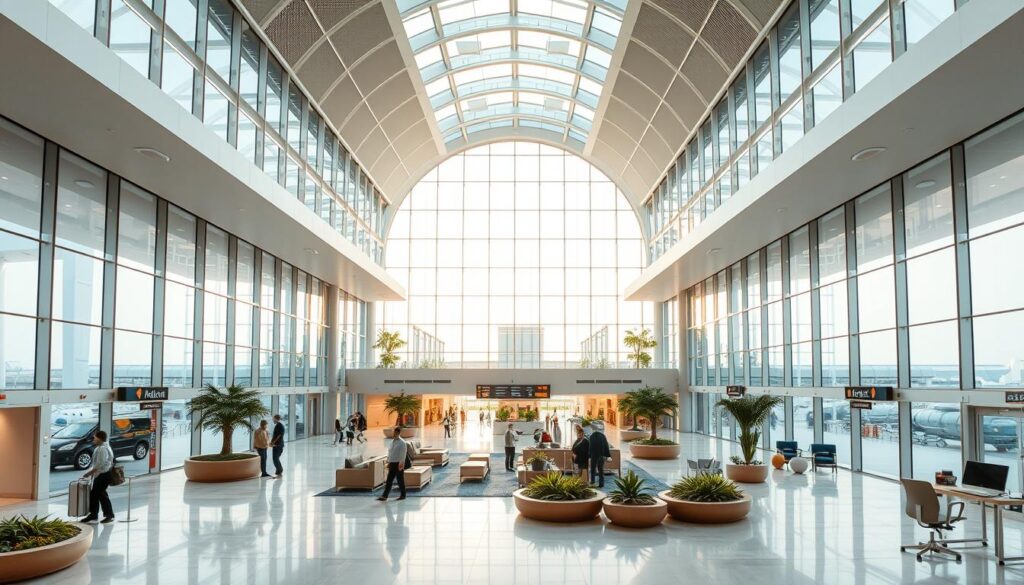Can a travel experience be transformed into a seamless and enjoyable journey? The answer lies in innovative terminal designs that prioritize the passenger experience.
According to Stantec, a renowned company in the field, “We design the entire passenger experience.” This involves incorporating intuitive wayfinding, art installations, and retail spaces to make traveling smoother and more enjoyable. For instance, Winnipeg’s new airport features transparent, luminous pavilions, which has earned it recognition as one of the top airports in the world.
By focusing on the entire passenger journey, airports can create a more enjoyable travel experience. This approach has been praised for its emphasis on transparency and visibility, allowing passengers to see their plane and navigate to it even before security.
Key Takeaways
- Innovative terminal designs enhance the passenger experience.
- Intuitive wayfinding and art installations improve travel.
- Transparency and visibility are key to modern terminal design.
- Stantec’s designs focus on the entire passenger journey.
- Examples like Winnipeg’s new airport showcase successful implementations.
The Importance of Airport Terminal Design
Innovative airport terminal design is key to enhancing both passenger experience and operational efficiency. As air travel continues to evolve, the role of well-designed terminals becomes increasingly vital.
The design of an airport terminal is not just about aesthetics; it’s about creating a seamless and enjoyable experience for travelers. By incorporating advanced technologies such as biometric-enabled self-service kiosks and automated bag drop systems, airports can significantly streamline processes, reducing wait times and enhancing overall efficiency.
Enhancing Passenger Experience
A well-designed terminal can greatly improve the passenger experience by providing clear signage, comfortable waiting areas, and a variety of amenities. For instance, Etihad Airways and Elenium have demonstrated the use of voice-activated self-service kiosks and bag drop facilities that utilize facial recognition technology, revolutionizing the travel experience.
“The future of airport terminals lies in their ability to adapt to new technologies and passenger needs, creating a more personalized and efficient travel experience.” –
Moreover, the layout and design of the terminal, as discussed in resources like Britannica, play a crucial role in passenger navigation and satisfaction. Effective terminal planning ensures that passengers can easily find their way through the airport, reducing stress and improving their overall experience.
Improving Operational Efficiency
Beyond enhancing passenger experience, a well-designed airport terminal also improves operational efficiency. By leveraging technologies such as automated systems and advanced data analytics, airports can optimize their operations, reduce costs, and improve security.
- Streamlining check-in and bag drop processes
- Enhancing security screening with advanced technologies
- Implementing smart signage for better wayfinding
As the aviation industry continues to grow, the importance of effective airport architecture and terminal planning cannot be overstated. By focusing on both passenger experience and operational efficiency, airports can create a competitive edge while improving the travel experience for millions of passengers.
Sustainability in Airport Terminal Design
As airports continue to evolve, sustainability has become a cornerstone in the design of modern airport terminals. The focus is on creating environmentally friendly spaces that not only reduce the carbon footprint but also enhance the overall passenger experience.
Eco-Friendly Materials and Practices
The use of eco-friendly materials is a significant aspect of sustainable airport design. Airports are now incorporating recycled materials and sustainable building practices into their construction projects. For instance, the use of reclaimed wood, low-carbon concrete, and energy-efficient insulation is becoming more prevalent. Moreover, airports are adopting practices like reducing waste and using renewable energy sources, such as solar and wind power, to minimize their environmental impact. To learn more about sustainable building materials, visit this resource on sustainable building materials.
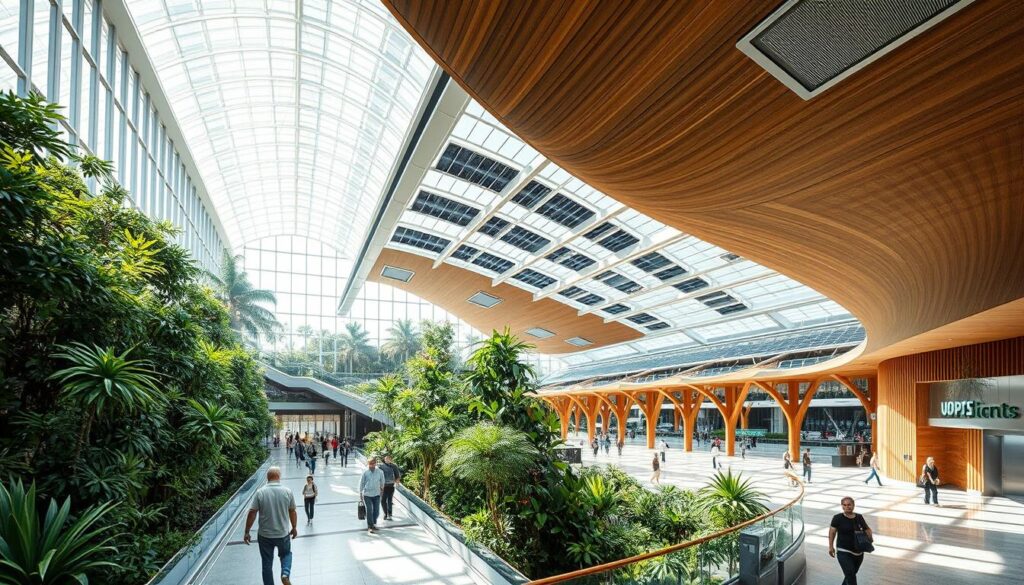
Energy Efficiency Initiatives
Energy efficiency is another critical component of sustainable airport terminal design. Airports are implementing various initiatives to reduce energy consumption, such as using LED lighting, optimizing HVAC systems, and incorporating energy-efficient technologies. These measures not only reduce the environmental footprint but also lead to significant cost savings over time. Furthermore, optimizing passenger flow through efficient terminal layouts can also contribute to a more sustainable operation by reducing the need for excessive energy consumption.
By integrating these sustainable practices and technologies, airports can create a more environmentally friendly and efficient travel experience. Effective airport interior design plays a crucial role in this endeavor, as it can significantly impact energy consumption and passenger experience.
The Role of Technology in Airport Terminals
Technology is transforming the airport experience, making it more efficient and user-friendly. The incorporation of advanced technological systems is enhancing terminal functionality and improving overall airport layout.
Smart Automation and Check-In Kiosks
One of the significant advancements in airport technology is the implementation of smart automation, including self-service check-in kiosks and automated bag drop systems. These innovations streamline the check-in process, reducing wait times for passengers. For more information on the technological systems used in airports, visit Airport Gurus.
Biometric Security Solutions
Biometric security solutions, such as facial recognition technology, are being increasingly adopted to enhance security while minimizing wait times. This technology allows for seamless passenger processing, improving the overall travel experience.
Real-Time Flight Information Displays
Real-time flight information displays are another crucial technology in modern airport terminals. These displays keep passengers informed about flight schedules, gate changes, and other important travel information, thereby reducing anxiety and improving the passenger experience.
| Technology | Benefit | Impact |
|---|---|---|
| Smart Automation | Streamlined Check-in | Reduced Wait Times |
| Biometric Security | Enhanced Security | Improved Passenger Experience |
| Real-Time Displays | Informed Passengers | Reduced Anxiety |
By integrating these technologies, airports can significantly enhance terminal functionality and create a more efficient, passenger-friendly environment.
Creating Space for Relaxation
The modern airport terminal is not just about transit; it’s about creating a serene travel experience. As airports continue to grow and evolve, the focus on providing spaces for relaxation and comfort is becoming increasingly important in terminal construction.
Airports are now recognizing the value of offering areas where travelers can unwind and rejuvenate. This shift is reflected in the design of quiet zones and lounges, which are becoming integral parts of the airport experience.
Quiet Zones and Lounges
Quiet zones and lounges are being designed to provide a peaceful escape from the hustle and bustle of the airport. These areas often feature comfortable seating, calming ambiance, and sometimes even serene views of the outside.
- Comfortable seating arrangements
- Calming ambiance through sound and lighting
- Serene views or art installations
Some airports are taking this a step further by incorporating wellness programs and meditation spaces into their lounge areas. These initiatives aim to reduce travel stress and enhance the overall passenger experience.
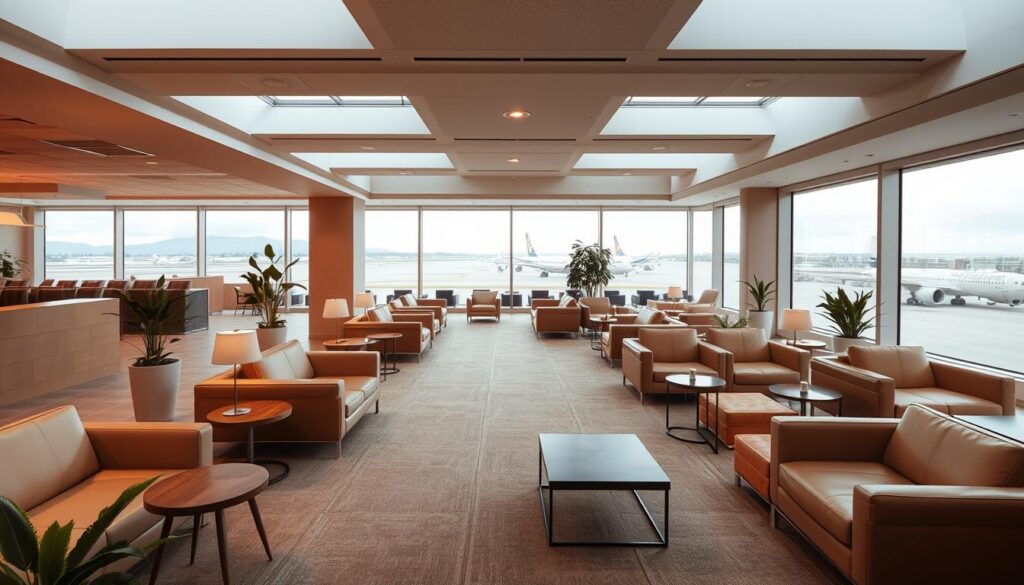
Features for Family and Children
In addition to quiet zones, airports are also focusing on creating family-friendly facilities. Play areas for children, kid-friendly dining options, and other amenities are being integrated into terminal designs to make travel more enjoyable for families.
Some notable features include:
- Interactive play zones
- Nursing rooms and family rest areas
- Kid-friendly dining and entertainment options
By incorporating these features, airports can create a more welcoming environment for travelers of all ages. The goal is to make the travel experience as comfortable and enjoyable as possible, from check-in to boarding.
“Airports are transforming into destinations in their own right, with a focus on comfort, relaxation, and family-friendly amenities.”
This approach not only enhances the passenger experience but also reflects a broader understanding of the role that airport terminals play in modern travel.
The Aesthetic Appeal of Airport Terminals
Airport terminals are now being designed with a keen eye on aesthetics, reflecting both modern trends and local culture. This shift towards beautifying airport terminals not only enhances the traveler’s experience but also gives airports a unique identity.
Architectural Trends in Modern Design
Modern airport terminals are showcasing stunning architectural designs. For instance, the undulating roof of Zayed International Airport’s new terminal, designed by KPF, is inspired by sand dunes. Such designs create a unique identity for the airport, making it a memorable part of the travel experience. As noted by industry experts, “The incorporation of dynamic architectural elements can significantly enhance the aesthetic appeal of airport terminals.”
“Airports are no longer just transit points; they are becoming destinations in their own right, with design playing a crucial role.”
Some of the key architectural trends include the use of sustainable materials, natural lighting, and innovative structural designs. These elements not only contribute to the aesthetic appeal but also improve the functionality of the terminal. For more insights on designing modern airport terminals, visit Happy Eco News.
The Integration of Local Culture
Incorporating local culture into airport design is becoming increasingly popular. This can be seen in the use of local art, traditional architectural styles, and cultural motifs. For example, Singapore Changi Airport incorporates elements of Singaporean culture in its design, creating a sense of place for travelers. The integration of local culture not only beautifies the airport but also provides travelers with a sense of the local environment even before they step out of the terminal.
The use of local culture in airport design can be seen in various forms, such as:
- Local art installations
- Traditional architectural elements
- Cultural motifs in decor
By embracing local culture, airports can create a unique and memorable experience for travelers, setting them apart from other airports around the world.
Functional Layouts for Enhanced Flow
Functional layouts are essential for managing the complex dynamics of airport terminals. A well-designed layout ensures that passengers can navigate the terminal efficiently, reducing congestion and improving the overall travel experience.
Effective airport terminal design involves creating a layout that caters to different travel needs. This can be achieved through zoning, where different areas are designated for specific activities such as check-in, security screening, and boarding.
Zoning for Different Travel Needs
Zoning is a critical aspect of airport architecture. By segregating areas for different activities, airports can streamline passenger flow and reduce bottlenecks. For instance, having a dedicated zone for check-in and baggage drop-off can help in managing the initial stages of the passenger journey more efficiently.
Moreover, zoning can be extended to include areas for relaxation, dining, and shopping, enhancing the overall passenger experience. For example, creating quiet zones or family-friendly areas can significantly improve passenger satisfaction.
Wayfinding Solutions
Wayfinding solutions are another crucial element in enhancing passenger flow. Clear and intuitive signage, along with digital guides, can help passengers navigate the terminal with ease. Effective wayfinding solutions reduce confusion and stress, making the travel experience more enjoyable.
For more insights on transportation network engineering and its impact on airport design, visit Transportation Network Engineering.
| Wayfinding Element | Description | Benefit |
|---|---|---|
| Clear Signage | Easy-to-read signs directing passengers to various facilities | Reduces confusion and stress |
| Digital Guides | Interactive displays providing real-time information | Enhances navigation and provides updates |
| Intuitive Maps | Simple and understandable maps of the terminal | Helps passengers plan their journey |
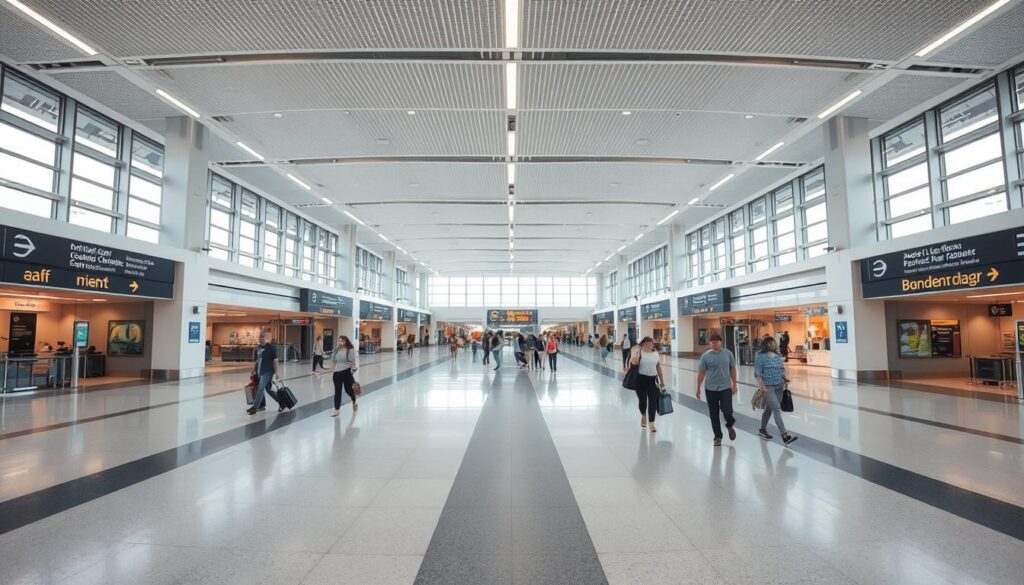
Flexibility in Terminal Design
Flexibility is a cornerstone of modern airport terminal design, enabling airports to adapt to evolving passenger needs. This adaptability is crucial for ensuring that terminals remain functional and efficient over time.
The key to achieving flexibility lies in incorporating design elements that can be easily modified or expanded as needed. Two critical strategies for achieving this flexibility are through the use of modular spaces and multi-use areas.
Modular Spaces for Changing Needs
Modular spaces are designed to be easily reconfigured or expanded to accommodate changing passenger demands. This can include modular check-in areas, security checkpoints, or retail spaces. By using modular design, airports can quickly respond to changes in passenger traffic or new security requirements without undergoing major renovations.
- Easy reconfiguration to meet changing needs
- Scalability to accommodate increased passenger traffic
- Reduced disruption during renovations
Multi-Use Areas
Multi-use areas are another critical component of flexible terminal design. These spaces can serve different purposes at different times, maximizing their utility and efficiency. For example, a lounge area might also serve as a meeting space or a temporary exhibition area.
- Maximizes space utility
- Enhances passenger experience through varied activities
- Supports diverse airport operations
By incorporating modular spaces and multi-use areas, airports can create terminals that are not only more adaptable to changing needs but also more efficient and passenger-friendly. This approach to terminal planning and airport interior design is essential for creating a positive and seamless travel experience.
Incorporating Retail and Dining Options
The passenger experience is significantly influenced by the availability and variety of retail and dining options within airport terminals. Airports that offer a diverse range of shopping and dining experiences can enhance passenger satisfaction and loyalty.
Airports are now incorporating a mix of popular international brands and unique local offerings to cater to diverse tastes and preferences. This not only improves the passenger experience but also contributes to the airport’s revenue.
Popular Food and Beverage Brands
The inclusion of well-known food and beverage brands is a key strategy in modern airport terminal design. Brands like Starbucks, Hudson News, and Duty-Free shops are commonly found in airports worldwide, providing passengers with familiar options.
Some airports also feature local brands and specialty stores, offering passengers a taste of the local culture. For example, an airport in a coffee-loving country might include a local coffee shop, while another might feature a renowned local chef’s restaurant.
| Brand | Type | Airport Presence |
|---|---|---|
| Starbucks | Coffee Shop | Multiple International Airports |
| Hudson News | Convenience Store | Many US and International Airports |
| Duty-Free | Retail | Airports Worldwide |
The Impact of Shopping Choices on Passenger Experience
The variety and quality of shopping choices significantly impact the passenger experience. Airports that offer a range of retail options can improve passenger satisfaction and create a more enjoyable travel experience.
Optimizing retail and dining options can also contribute to passenger flow optimization by reducing congestion in other areas of the terminal. By providing a pleasant and engaging environment, airports can enhance overall terminal functionality.
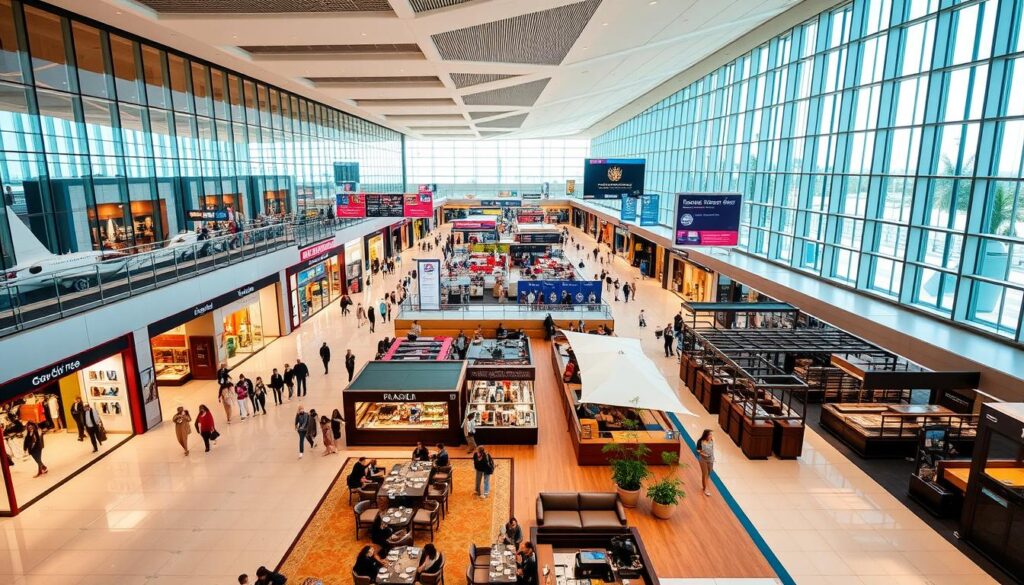
By carefully curating retail and dining options, airports can create a positive and memorable experience for passengers, ultimately driving loyalty and revenue.
Safety and Security Considerations
The safety and security of passengers is a critical consideration in airport layout and terminal construction. Ensuring that airport terminals are designed to effectively respond to emergency situations and incorporate advanced security technologies is paramount.
Designing facilities with emergency situations in mind involves creating clear evacuation routes and having robust emergency response plans in place. This includes:
- Implementing fire safety measures and conducting regular drills.
- Training staff to respond to various emergency scenarios.
- Ensuring that passengers are aware of emergency procedures through clear signage and announcements.
Designing for Emergency Situations
Effective emergency planning is crucial for maintaining safety within airport terminals. This involves not only having the right infrastructure but also ensuring that staff are trained to handle emergencies.
| Emergency Measure | Description | Benefits |
|---|---|---|
| Clear Evacuation Routes | Clearly marked paths for quick exit | Reduces panic and ensures swift evacuation |
| Fire Safety Measures | Installation of fire alarms and suppression systems | Minimizes risk of fire-related incidents |
| Staff Training | Regular training for staff on emergency response | Enhances response efficiency and passenger safety |
Incorporating Surveillance Technologies
The incorporation of advanced surveillance technologies is a key aspect of enhancing security in airport terminals. This includes the use of CCTV cameras, access control systems, and biometric screening.
These technologies help in monitoring and controlling access to secure areas, thereby preventing unauthorized access and potential security breaches.
By integrating these safety and security measures, airport terminals can provide a secure environment for passengers, thereby enhancing their overall travel experience.
Importance of Natural Lighting
Incorporating natural lighting into airport terminals is a growing trend, driven by its positive impact on passengers and energy efficiency. Natural lighting not only enhances the aesthetic appeal of the terminal but also plays a crucial role in reducing the need for artificial lighting, thereby saving energy.
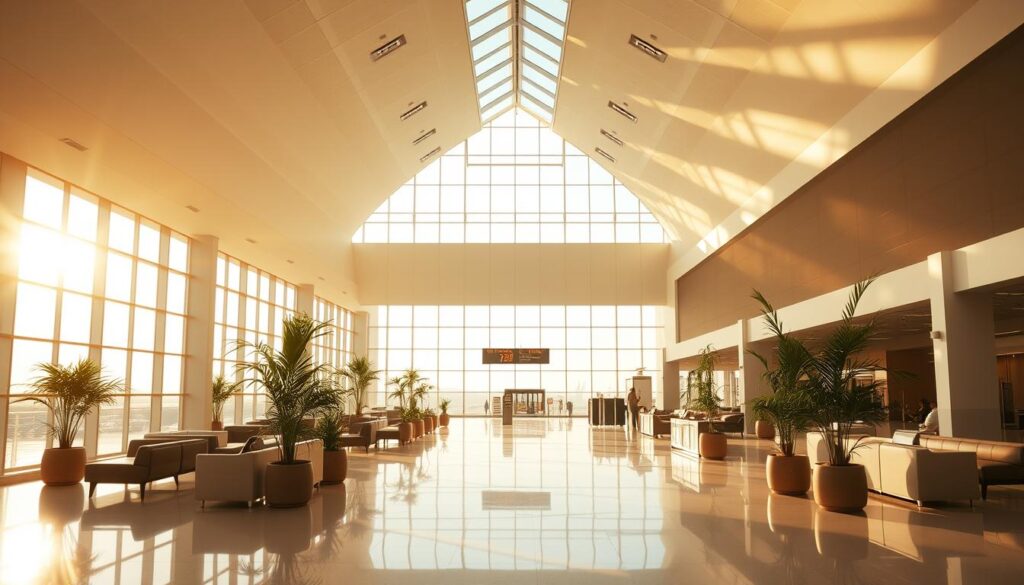
Benefits of Skylights and Windows
Skylights and windows are effective ways to introduce natural lighting into airport terminals. These design elements not only reduce the reliance on artificial lighting but also provide passengers with a sense of connection to the outside environment. The benefits include:
- Improved passenger well-being
- Enhanced aesthetic appeal
- Energy efficiency
By incorporating skylights and windows, airports can create a more welcoming atmosphere. For more insights on innovative airport design, visit Airport Gurus for information on creating sustainable spaces.
Biophilic Design in Airports
Biophilic design, which incorporates elements of nature into the built environment, is becoming increasingly popular in airport design. This approach not only enhances the visual appeal of the terminal but also contributes to a more natural and calming ambiance. Some key elements of biophilic design include:
- Natural materials
- Green spaces
- Water features
The integration of biophilic design elements can significantly improve the passenger experience, making airports more enjoyable and reducing stress. As the trend towards more sustainable and passenger-centric airport design continues, the incorporation of natural lighting and biophilic elements is expected to play a key role.
Passenger-Centric Amenities
As air travel continues to evolve, the focus on passenger-centric amenities in airport design has become more pronounced. Modern airports are recognizing the importance of providing a comfortable and enjoyable experience for travelers.
Charging Stations and Wi-Fi Availability
In today’s digital age, staying connected is crucial. Airports are now prioritizing the installation of charging stations and offering reliable Wi-Fi connectivity to ensure passengers remain connected throughout their journey. This not only enhances the passenger experience but also supports productivity for business travelers.
Health and Wellness Options
Beyond connectivity, airports are also focusing on health and wellness options. This includes the incorporation of gyms, spas, and healthy dining choices to support passenger well-being. By providing these amenities, airports can significantly improve the overall travel experience, making it more enjoyable and less stressful for passengers.
The inclusion of health and wellness options reflects a broader trend in airport design towards creating a more holistic travel experience. As airports continue to evolve, we can expect to see even more innovative solutions aimed at enhancing passenger comfort and satisfaction.
Future Trends in Airport Terminal Design
Airport terminal design is on the cusp of a revolution, driven by technological innovations and evolving passenger expectations. As we look to the future, it’s clear that airport terminals will need to adapt to changing demands, incorporating new technologies and design principles to enhance the passenger experience and improve operational efficiency.
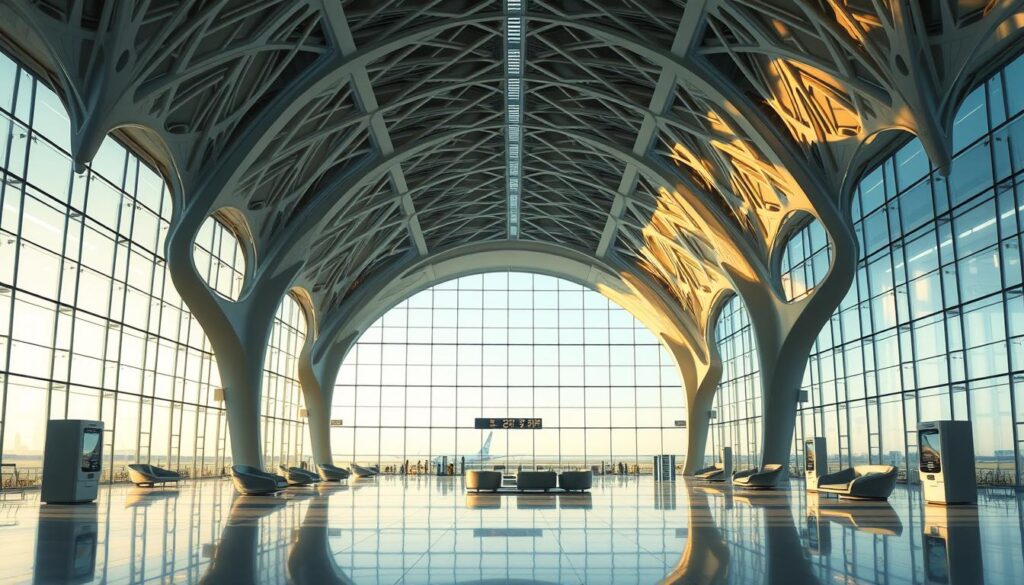
Innovations on the Horizon
The next decade will see significant advancements in airport interior design, with a focus on creating more efficient, sustainable, and passenger-friendly environments. Some of the key innovations include:
- Advanced biometric technologies to streamline passenger processing
- Artificial intelligence to enhance operational efficiency and personalize passenger experiences
- Sustainable materials and practices to reduce environmental impact
- Dynamic signage and wayfinding solutions to improve passenger flow optimization
These innovations will not only improve the passenger experience but also contribute to a more efficient and sustainable airport operation. For instance, the use of biometric technologies can significantly reduce wait times, while sustainable materials can minimize the airport’s carbon footprint.
Predictions for the Next Decade
Looking ahead to the next decade, we can anticipate that airport terminals will become even more integrated with technology, enhancing both the passenger experience and operational efficiency. According to a recent article on Future Travel Experience, several technology and CX trends are expected to shape airline and airport operations in 2024, including the adoption of advanced biometric technologies and AI-driven solutions.
Some key predictions for the next decade include:
- Increased use of AI and machine learning to predict and manage passenger flow
- More widespread adoption of biometric technologies for security and check-in
- Greater emphasis on sustainability, with the use of renewable energy sources and eco-friendly materials
- Enhanced passenger experience through personalized services and dynamic information displays
By embracing these trends and innovations, airports can create a more efficient, sustainable, and enjoyable travel experience for passengers.
Case Studies of Innovative Airport Designs
Innovative airport designs are redefining the passenger experience worldwide. Examining these designs provides valuable insights into successful strategies and best practices that can be applied to future projects, enhancing terminal functionality and improving airport layout.
Successful Implementations
Singapore Changi Airport’s Jewel, with its stunning indoor garden and waterfall, is a prime example of innovative design. Such case studies demonstrate how effective airport layout and terminal functionality can significantly enhance the passenger experience.
Applying Lessons Learned
By analyzing these case studies, architects and designers can identify best practices and strategies to create functional, sustainable, and passenger-centric airports. This knowledge can be applied to future airport design projects, ensuring they meet the evolving needs of travelers.
